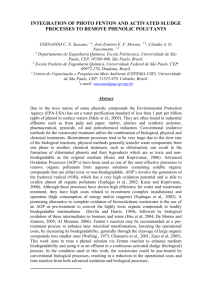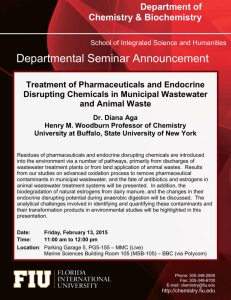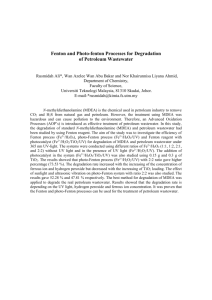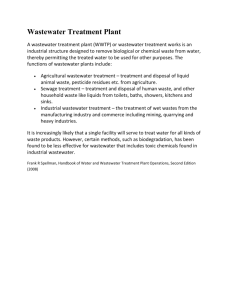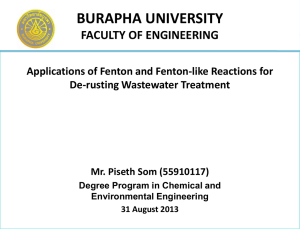Bioremediation
advertisement
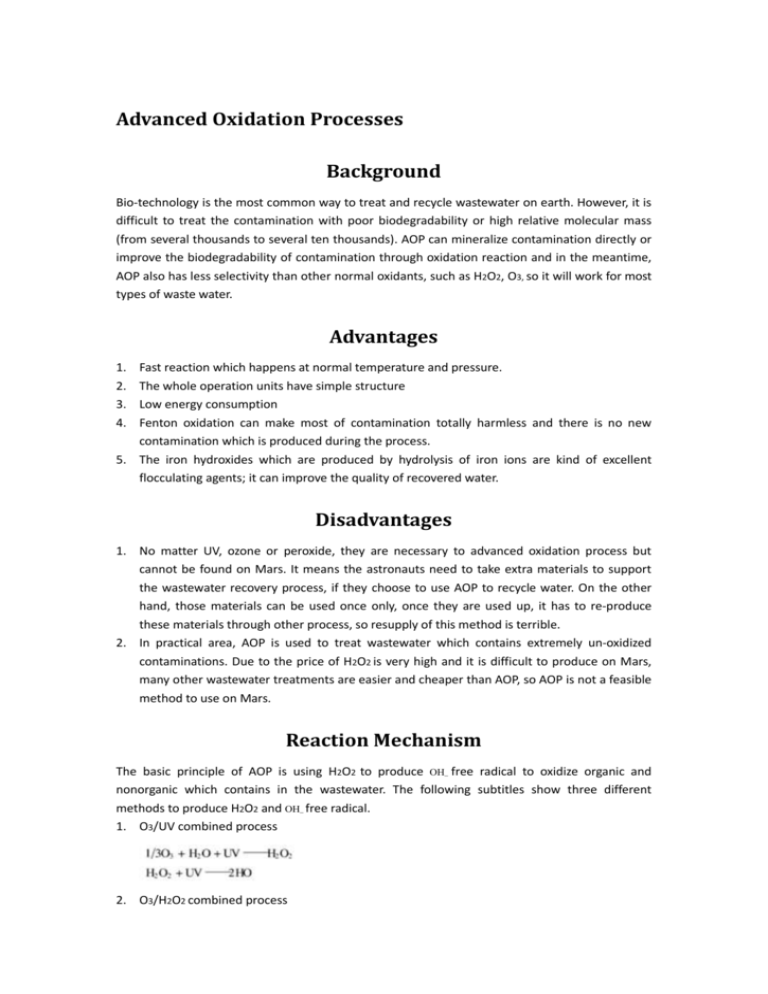
Advanced Oxidation Processes Background Bio-technology is the most common way to treat and recycle wastewater on earth. However, it is difficult to treat the contamination with poor biodegradability or high relative molecular mass (from several thousands to several ten thousands). AOP can mineralize contamination directly or improve the biodegradability of contamination through oxidation reaction and in the meantime, AOP also has less selectivity than other normal oxidants, such as H2O2, O3, so it will work for most types of waste water. Advantages 1. 2. 3. 4. Fast reaction which happens at normal temperature and pressure. The whole operation units have simple structure Low energy consumption Fenton oxidation can make most of contamination totally harmless and there is no new contamination which is produced during the process. 5. The iron hydroxides which are produced by hydrolysis of iron ions are kind of excellent flocculating agents; it can improve the quality of recovered water. Disadvantages 1. No matter UV, ozone or peroxide, they are necessary to advanced oxidation process but cannot be found on Mars. It means the astronauts need to take extra materials to support the wastewater recovery process, if they choose to use AOP to recycle water. On the other hand, those materials can be used once only, once they are used up, it has to re-produce these materials through other process, so resupply of this method is terrible. 2. In practical area, AOP is used to treat wastewater which contains extremely un-oxidized contaminations. Due to the price of H2O2 is very high and it is difficult to produce on Mars, many other wastewater treatments are easier and cheaper than AOP, so AOP is not a feasible method to use on Mars. Reaction Mechanism The basic principle of AOP is using H2O2 to produce OH_ free radical to oxidize organic and nonorganic which contains in the wastewater. The following subtitles show three different methods to produce H2O2 and OH_ free radical. 1. O3/UV combined process 2. O3/H2O2 combined process 3. Fenton Process Fenton oxidant is a mixture of Fe2+ and H2O2. Although Fe2+ ions will reacted with some un-oxidized components to produce sentimental deposit then deposit can be exhausted from the bottom of storage tank easily, the treated water still contains redundant Fe2+ ions, so secondary process to remove Fe2+ ions from water is necessary. Bioremediation Bioremediation method is using enzymes, bacteria or natural organisms to consume contaminants. This is similar to digestion but usually tailored to specific chemicals. Micro-organisms are highly sensitive to environmental changes such as temperature and pressure. Relying on living organisms for life support, increases risk Most of enzymes can only consume a few types of contaminants, bacteria has strong limitation on consuming contaminant. All in all, bioremediation is too specific for waste water treatment, whatever in operating condition or consume waste, so the efficiency of this process would be low. In practical industrial area, bioremediation is usually used as one step of the whole wastewater treatment process to remove or consume the specific component which is contained in contaminants. The following figure shows a combined process with bioremediation and advance oxidation process, the wastewater enters the sedimentation tank first to process initial separation between liquid and solid contaminants, then it move into electrolytic cell, add H2O2 to generate strong oxidant hydroxyl radicals (OH-). Treated effluents then are placed in decanter tanks to eliminate sludge formed during electrolysis; and then goes into a multi-stages bio-reactor, according to the components of contaminants to choose suitable enzymes/ bacteria/ natural organisms to consume particular contaminants, improve the quality of treated water. Finally, it enters the second electrolytic cell: iron ion reacts with those non-oxidized components to generate sediment for purifying the final exited water. During this process, the non-biodegradable organics and toxic pollutants present in the wastewaters such as polyphenols are usually destroyed by direct or indirect anodic oxidation via the production of oxidants such as hydroxyl radicals and complex coagulants that promote the flocculation of the matter. Additional information The following tables show some basic information about components and contents of wastewater which may be produced in Mars space station. Condensate Wastewater Hygiene Wastewater Components Contents Contents Chemical Oxygen Consumption (mgO2/L) 250-650 2500-5000 Ammonia (mg/L) 50 <80 Chloride (mg/L) 25 <10 Sulfate (mg/L) <5 <300 Nitrate (mg/L) <1 <1000 Alcohols (mg/L) <300 Acid (mg/L) <30 Number of Bacterial (/L) 104-107 106-108 Urine Wastewater Components Contents Urea (mg/L) 13000-20000 Sodium Chloride (mg/L) 8000-12000 Sarcosine (mg/L) 400-1600 Phosphate Radical (mg/L) 1300-1500 Ammonia (mg/L) 70-80 Hippuric Acid (mg/L) 100-1600 Uric Acid (mg/L) 200-800 Potassium (mg/L) 1500-2000 Calcium (mg/L) 150-700 Magnesium (mg/L) 150-250 Carbonate (mg/L) 1200-1400 Sulfate (mg/L) 1000-2000 Amino Acid (mg/L) 150-350 Fatty Acid (mg/L) 30-60 Phenol (mg/L) 100-300 Reductive Water From Carbon Dioxide Components Contents H (mg/L) <0.045 CH (mg/L) <10 CO (mg/L) <850 Ammonia (mg/L) <10 Cation (mg/L) <3 Desired Species of Metabolic Process and Waste from Bodies Substance Supply (kg/day) Waste Discharge (kg/day) Drinking Water 1.86 Urine 1.5 Rehydrated Food 0.72 Breath and Sweat 0.83 Hydrous Food 0.5 Excrement 0.09 Produced Water through Metabolism 0.34 Oxygen 0.83 Carbon Dioxide 1.0 Water Used for Cleaning and Waste Supply (kg/day) Discharge (kg/day) Washing Clothes 12.49 Liquid 11.88 Gas 0.61 Washing Dishware 2.0 Liquid 1.98 Gas 0.02 Shower 5.55 Liquid 5.11 Gas 0.44
